Employment Discrimination at Starbucks: A Case Study Report, BMGT3001
VerifiedAdded on 2022/08/16
|11
|3022
|19
Report
AI Summary
This report examines the employment discrimination case at Starbucks involving Meseret Kumulchew, who faced discrimination due to her dyslexia. The report provides a brief history of Starbucks and outlines the details of the case, where Kumulchew was treated unfairly and faced accusations of fraud due to her disability. It then delves into the ethical dimensions of the case, arguing that Starbucks' actions were unethical and illegal. The report analyzes the case through the lens of ethical decision-making approaches and theories, including utilitarianism, deontology, and virtue ethics, to demonstrate the ethical failures of the organization. The conclusion reinforces the need for ethical behavior and fair treatment of employees, highlighting the importance of understanding and addressing discrimination in the workplace. The report also references several academic sources to support its arguments and findings.
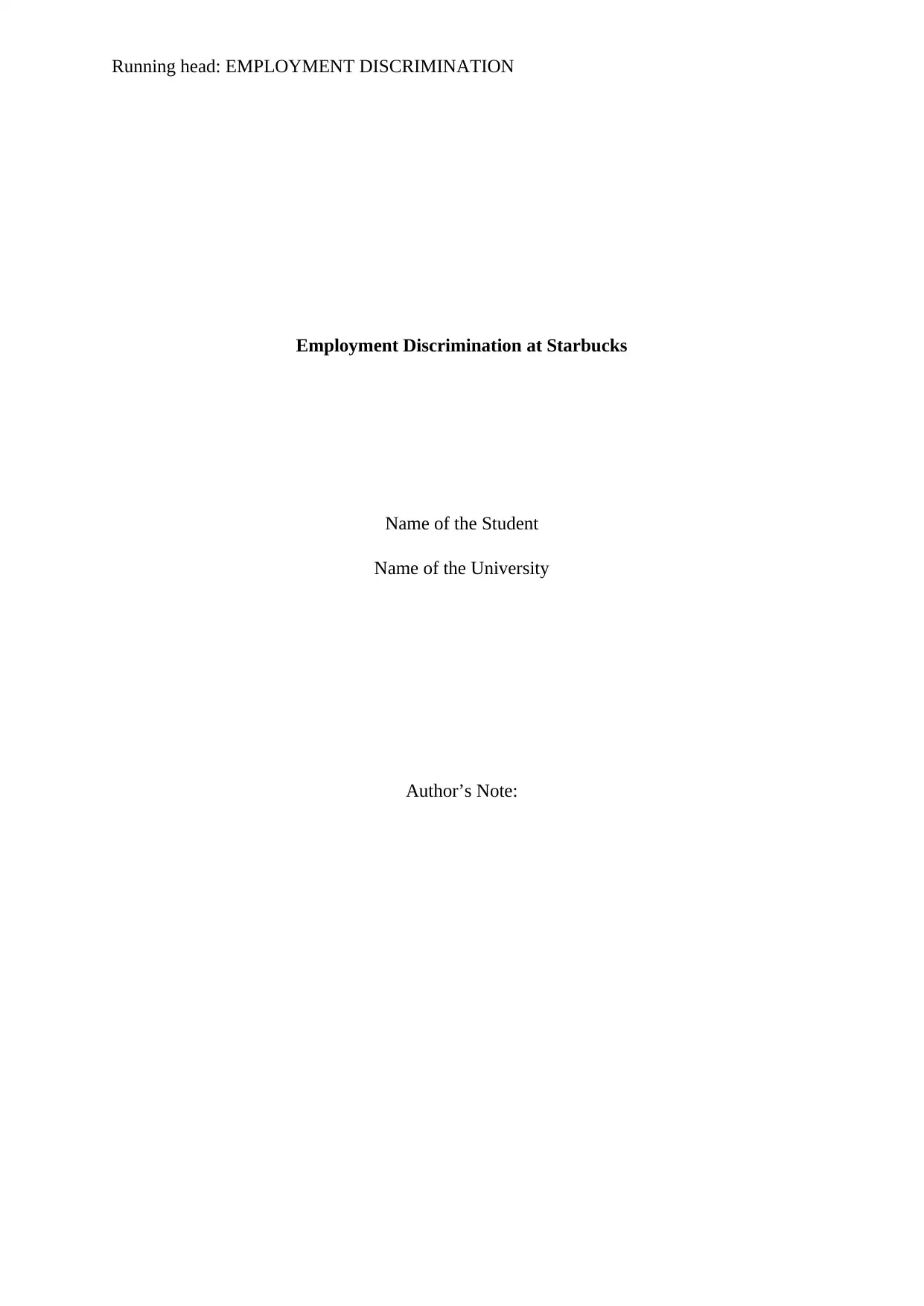
Running head: EMPLOYMENT DISCRIMINATION
Employment Discrimination at Starbucks
Name of the Student
Name of the University
Author’s Note:
Employment Discrimination at Starbucks
Name of the Student
Name of the University
Author’s Note:
Paraphrase This Document
Need a fresh take? Get an instant paraphrase of this document with our AI Paraphraser

1
EMPLOYMENT DISCRIMINATION
Executive Summary
The objective of the report is to understand the concept of employment discrimination after
considering the popular case study of Starbucks, where an employee called, Meseret
Kumulchew was discriminated on the basis of her medical condition of Dyslexia. Workplace
discrimination could come in several formats and such distinct misconduct could be overt and
ensure denial of advanced opportunities. This specific activity takes place when a member of
any protected class is being treated differently than his or her colleagues or peers. The laws of
employment discrimination is responsible for highlighting the most basic issues related to
work place ethics and understanding the respective wrong effects and impacts on the
organizational culture. This report has highlighted the approaches as well as theories for
ethical decision making for understanding the entire case study eventually.
EMPLOYMENT DISCRIMINATION
Executive Summary
The objective of the report is to understand the concept of employment discrimination after
considering the popular case study of Starbucks, where an employee called, Meseret
Kumulchew was discriminated on the basis of her medical condition of Dyslexia. Workplace
discrimination could come in several formats and such distinct misconduct could be overt and
ensure denial of advanced opportunities. This specific activity takes place when a member of
any protected class is being treated differently than his or her colleagues or peers. The laws of
employment discrimination is responsible for highlighting the most basic issues related to
work place ethics and understanding the respective wrong effects and impacts on the
organizational culture. This report has highlighted the approaches as well as theories for
ethical decision making for understanding the entire case study eventually.
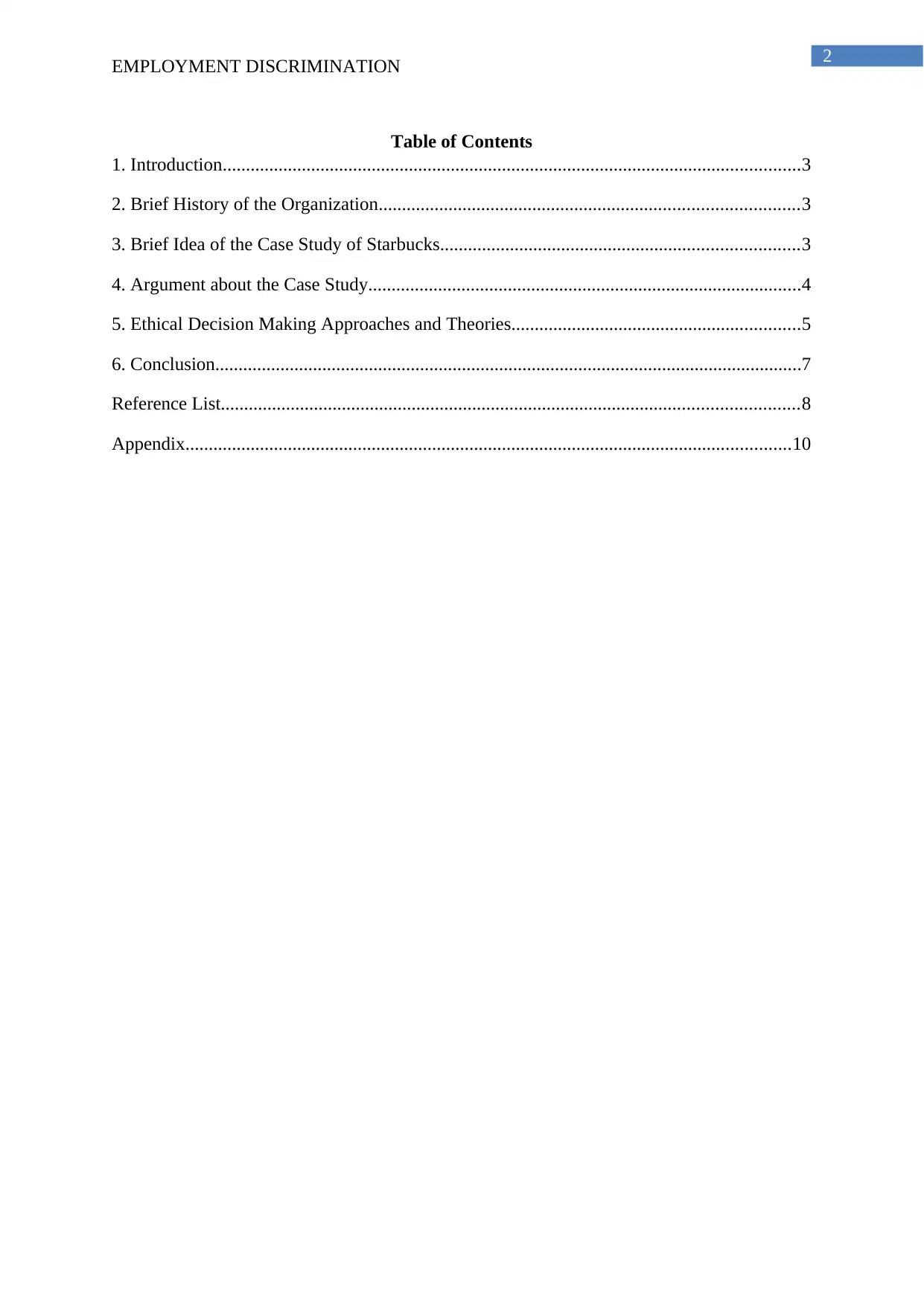
2
EMPLOYMENT DISCRIMINATION
Table of Contents
1. Introduction............................................................................................................................3
2. Brief History of the Organization..........................................................................................3
3. Brief Idea of the Case Study of Starbucks.............................................................................3
4. Argument about the Case Study.............................................................................................4
5. Ethical Decision Making Approaches and Theories..............................................................5
6. Conclusion..............................................................................................................................7
Reference List............................................................................................................................8
Appendix..................................................................................................................................10
EMPLOYMENT DISCRIMINATION
Table of Contents
1. Introduction............................................................................................................................3
2. Brief History of the Organization..........................................................................................3
3. Brief Idea of the Case Study of Starbucks.............................................................................3
4. Argument about the Case Study.............................................................................................4
5. Ethical Decision Making Approaches and Theories..............................................................5
6. Conclusion..............................................................................................................................7
Reference List............................................................................................................................8
Appendix..................................................................................................................................10
⊘ This is a preview!⊘
Do you want full access?
Subscribe today to unlock all pages.

Trusted by 1+ million students worldwide

3
EMPLOYMENT DISCRIMINATION
1. Introduction
Employment discrimination can be referred to as a basic form of discrimination on the
basis of race, gender, religion, mental or physical disabilities, gender identity, age and
national origins by their respective employers (See Appendix). The difference in earnings or
qualifications does not fall under the criterion of employment discrimination. It could be
eventually intended and include disparate treatment of the group for ensuring a disparate
effect for the entire group (Zimmer and Sullivan 2017). Proper information should be
provided to each and every organizational member for ensuring that any type of harassment
or discrimination is successfully eradicated without much complexity and the process of
organizational activities is smooth and effective. Several significant and popular
organizations have faced discrimination for their employees (Dietz et al. 2015). The
following report outlines a brief discussion on employment discrimination, occurred in one of
the most popular restaurants in the world, Starbucks with relevant details related to ethical
decision making approach and theory.
2. Brief History of the Organization
Starbucks Corporation is one of the most significant and popular coffee company as
well as coffee house chain. This particular organization was founded in the year of 1971 in
Seattle, Washington, United States of America by Jerry Baldwin, Zev Seigl and Gordon
Bowker. The headquarters of this specific company is in Seattle, USA (Starbucks Coffee
Company. 2020). Until the year of 2019, the organization operated in more than thirty
thousand locations in the entire world. Starbucks has been described as the major
representative of a 2nd wave coffee, which is a popular movement for artisanal coffee,
subsequently dark roasted coffee. On the contrary, the third wave coffee makers have
eventually targeted quality minded coffee drinkers with the handmade coffee based on the
light roasts. Currently, Starbucks is utilizing an automatic espresso machine for both safety
and efficiency reasons (Starbucks Coffee Company. 2020). The locations of Starbucks
eventually serve cold and hot drink, micro grounded instant coffee termed as VIA, caffe latte,
espresso, loose and full leaf tea like Teavana tea product, Frappuccino beverage, pastries,
snacks and many more. Starbucks is also involving high operating income, net income and
total equity and as a result, they are obtaining maximum success in their business without
much complexity.
3. Brief Idea of the Case Study of Starbucks
EMPLOYMENT DISCRIMINATION
1. Introduction
Employment discrimination can be referred to as a basic form of discrimination on the
basis of race, gender, religion, mental or physical disabilities, gender identity, age and
national origins by their respective employers (See Appendix). The difference in earnings or
qualifications does not fall under the criterion of employment discrimination. It could be
eventually intended and include disparate treatment of the group for ensuring a disparate
effect for the entire group (Zimmer and Sullivan 2017). Proper information should be
provided to each and every organizational member for ensuring that any type of harassment
or discrimination is successfully eradicated without much complexity and the process of
organizational activities is smooth and effective. Several significant and popular
organizations have faced discrimination for their employees (Dietz et al. 2015). The
following report outlines a brief discussion on employment discrimination, occurred in one of
the most popular restaurants in the world, Starbucks with relevant details related to ethical
decision making approach and theory.
2. Brief History of the Organization
Starbucks Corporation is one of the most significant and popular coffee company as
well as coffee house chain. This particular organization was founded in the year of 1971 in
Seattle, Washington, United States of America by Jerry Baldwin, Zev Seigl and Gordon
Bowker. The headquarters of this specific company is in Seattle, USA (Starbucks Coffee
Company. 2020). Until the year of 2019, the organization operated in more than thirty
thousand locations in the entire world. Starbucks has been described as the major
representative of a 2nd wave coffee, which is a popular movement for artisanal coffee,
subsequently dark roasted coffee. On the contrary, the third wave coffee makers have
eventually targeted quality minded coffee drinkers with the handmade coffee based on the
light roasts. Currently, Starbucks is utilizing an automatic espresso machine for both safety
and efficiency reasons (Starbucks Coffee Company. 2020). The locations of Starbucks
eventually serve cold and hot drink, micro grounded instant coffee termed as VIA, caffe latte,
espresso, loose and full leaf tea like Teavana tea product, Frappuccino beverage, pastries,
snacks and many more. Starbucks is also involving high operating income, net income and
total equity and as a result, they are obtaining maximum success in their business without
much complexity.
3. Brief Idea of the Case Study of Starbucks
Paraphrase This Document
Need a fresh take? Get an instant paraphrase of this document with our AI Paraphraser
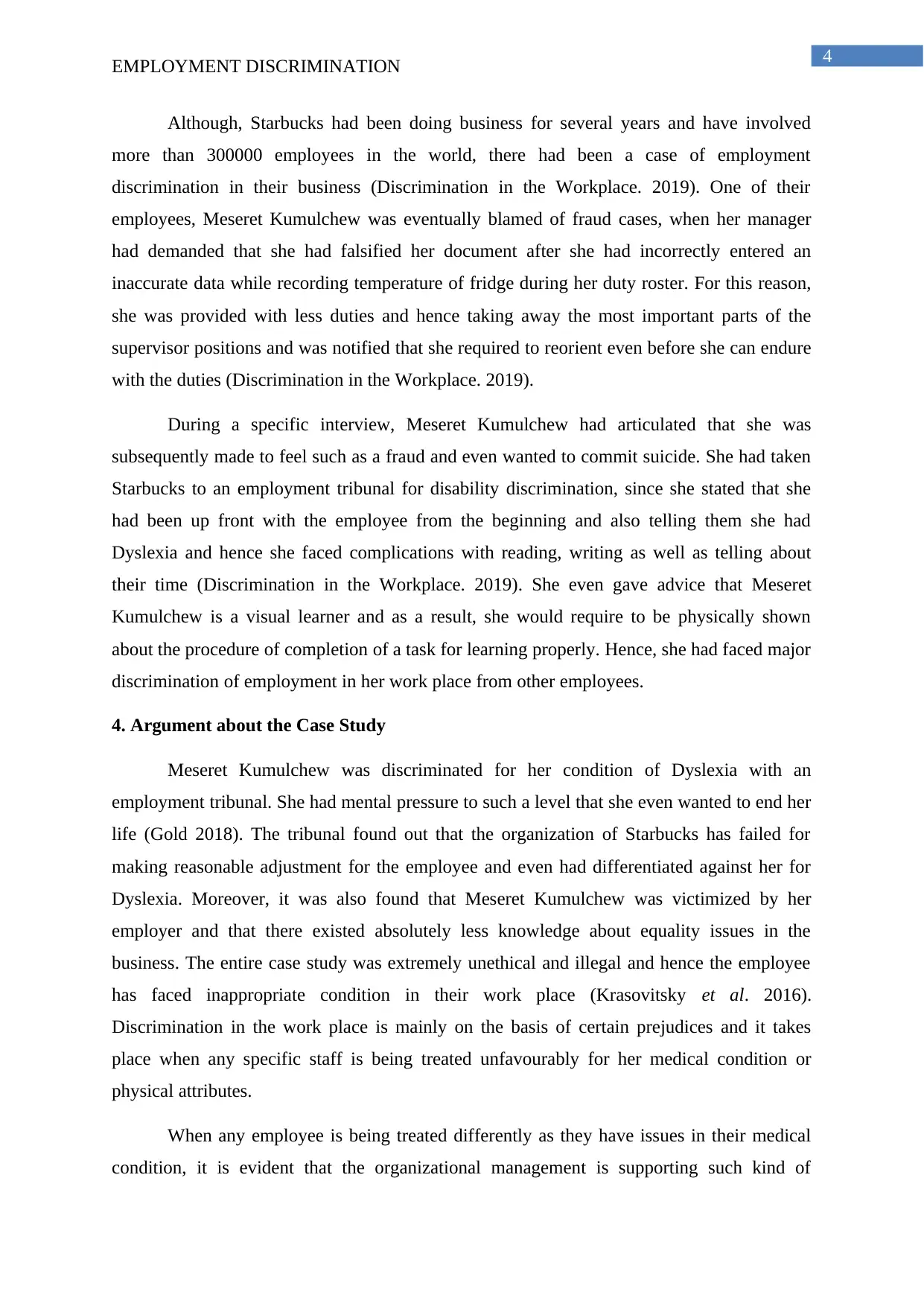
4
EMPLOYMENT DISCRIMINATION
Although, Starbucks had been doing business for several years and have involved
more than 300000 employees in the world, there had been a case of employment
discrimination in their business (Discrimination in the Workplace. 2019). One of their
employees, Meseret Kumulchew was eventually blamed of fraud cases, when her manager
had demanded that she had falsified her document after she had incorrectly entered an
inaccurate data while recording temperature of fridge during her duty roster. For this reason,
she was provided with less duties and hence taking away the most important parts of the
supervisor positions and was notified that she required to reorient even before she can endure
with the duties (Discrimination in the Workplace. 2019).
During a specific interview, Meseret Kumulchew had articulated that she was
subsequently made to feel such as a fraud and even wanted to commit suicide. She had taken
Starbucks to an employment tribunal for disability discrimination, since she stated that she
had been up front with the employee from the beginning and also telling them she had
Dyslexia and hence she faced complications with reading, writing as well as telling about
their time (Discrimination in the Workplace. 2019). She even gave advice that Meseret
Kumulchew is a visual learner and as a result, she would require to be physically shown
about the procedure of completion of a task for learning properly. Hence, she had faced major
discrimination of employment in her work place from other employees.
4. Argument about the Case Study
Meseret Kumulchew was discriminated for her condition of Dyslexia with an
employment tribunal. She had mental pressure to such a level that she even wanted to end her
life (Gold 2018). The tribunal found out that the organization of Starbucks has failed for
making reasonable adjustment for the employee and even had differentiated against her for
Dyslexia. Moreover, it was also found that Meseret Kumulchew was victimized by her
employer and that there existed absolutely less knowledge about equality issues in the
business. The entire case study was extremely unethical and illegal and hence the employee
has faced inappropriate condition in their work place (Krasovitsky et al. 2016).
Discrimination in the work place is mainly on the basis of certain prejudices and it takes
place when any specific staff is being treated unfavourably for her medical condition or
physical attributes.
When any employee is being treated differently as they have issues in their medical
condition, it is evident that the organizational management is supporting such kind of
EMPLOYMENT DISCRIMINATION
Although, Starbucks had been doing business for several years and have involved
more than 300000 employees in the world, there had been a case of employment
discrimination in their business (Discrimination in the Workplace. 2019). One of their
employees, Meseret Kumulchew was eventually blamed of fraud cases, when her manager
had demanded that she had falsified her document after she had incorrectly entered an
inaccurate data while recording temperature of fridge during her duty roster. For this reason,
she was provided with less duties and hence taking away the most important parts of the
supervisor positions and was notified that she required to reorient even before she can endure
with the duties (Discrimination in the Workplace. 2019).
During a specific interview, Meseret Kumulchew had articulated that she was
subsequently made to feel such as a fraud and even wanted to commit suicide. She had taken
Starbucks to an employment tribunal for disability discrimination, since she stated that she
had been up front with the employee from the beginning and also telling them she had
Dyslexia and hence she faced complications with reading, writing as well as telling about
their time (Discrimination in the Workplace. 2019). She even gave advice that Meseret
Kumulchew is a visual learner and as a result, she would require to be physically shown
about the procedure of completion of a task for learning properly. Hence, she had faced major
discrimination of employment in her work place from other employees.
4. Argument about the Case Study
Meseret Kumulchew was discriminated for her condition of Dyslexia with an
employment tribunal. She had mental pressure to such a level that she even wanted to end her
life (Gold 2018). The tribunal found out that the organization of Starbucks has failed for
making reasonable adjustment for the employee and even had differentiated against her for
Dyslexia. Moreover, it was also found that Meseret Kumulchew was victimized by her
employer and that there existed absolutely less knowledge about equality issues in the
business. The entire case study was extremely unethical and illegal and hence the employee
has faced inappropriate condition in their work place (Krasovitsky et al. 2016).
Discrimination in the work place is mainly on the basis of certain prejudices and it takes
place when any specific staff is being treated unfavourably for her medical condition or
physical attributes.
When any employee is being treated differently as they have issues in their medical
condition, it is evident that the organizational management is supporting such kind of

5
EMPLOYMENT DISCRIMINATION
discrimination (Midtbøen 2015). A direct discrimination eventually occurs when any
employee is being treated less favourably than the other employees and similar thing was
faced by Meseret Kumulchew in Starbucks. Moreover, the organizational management has
accused her that she was falsifying the documents and she was not medically unfit. It was
highly unprofessional and unethical, as compared to the other employees and hence the
respective employee was mentally disturbed to a high level (Sargeant 2016). Moreover, there
even existed an issue of indirect discrimination, in which certain rules or regulations for
putting the staff members at subsequent disadvantage.
5. Ethical Decision Making Approaches and Theories
Work ethics refer to as the set of few moral principles that is being utilized by
particular individual in their job (Flake 2015). The individuals, who possess strong work
ethics in his or her work, could easily embody few principles, which guide the work
behaviour; hence leading them in producing high quality work constantly and the respective
output could motivate them in remaining on the track. It is an ethical belief that diligence and
hard work is comprising of moral benefits as well as an inherent capability, values or virtue
for the purpose of strengthening individual and character abilities (Wang 2016). It is the set
of values that are centred on the significance of work and manifested by subsequent
determination or desire towards hard work.
This type of work ethics is also responsible for ensuring that no employee or staff is
discriminated under any circumstance (Walani 2015). Social involvement of the value is
eventually considered for enhancing character through major hard work, which is respective
to the work field of an individual. The vital proponents of a strong work ethics help in
obtaining the objectives easily and promptly and also ensure that each and every employee is
working after focusing on organizational ethics. In this particular case study of Starbucks, the
organizational member of Meseret Kumulchew has faced employment discrimination from
other employees due to her medical condition of Dyslexia (Bunel, L’Horty and Petit 2016).
As a result, she was highly demotivated with such unethical approach, in respect to the self-
respect, fulfilment and satisfaction towards work.
The existing ethical decision making approaches and theories subsequently prove that
the organization was following an unethical approach towards the respective employee
(Triana, Jayasinghe and Pieper 2015). Suitable ethical theories for this specified case scenario
are provided in the following paragraphs:
EMPLOYMENT DISCRIMINATION
discrimination (Midtbøen 2015). A direct discrimination eventually occurs when any
employee is being treated less favourably than the other employees and similar thing was
faced by Meseret Kumulchew in Starbucks. Moreover, the organizational management has
accused her that she was falsifying the documents and she was not medically unfit. It was
highly unprofessional and unethical, as compared to the other employees and hence the
respective employee was mentally disturbed to a high level (Sargeant 2016). Moreover, there
even existed an issue of indirect discrimination, in which certain rules or regulations for
putting the staff members at subsequent disadvantage.
5. Ethical Decision Making Approaches and Theories
Work ethics refer to as the set of few moral principles that is being utilized by
particular individual in their job (Flake 2015). The individuals, who possess strong work
ethics in his or her work, could easily embody few principles, which guide the work
behaviour; hence leading them in producing high quality work constantly and the respective
output could motivate them in remaining on the track. It is an ethical belief that diligence and
hard work is comprising of moral benefits as well as an inherent capability, values or virtue
for the purpose of strengthening individual and character abilities (Wang 2016). It is the set
of values that are centred on the significance of work and manifested by subsequent
determination or desire towards hard work.
This type of work ethics is also responsible for ensuring that no employee or staff is
discriminated under any circumstance (Walani 2015). Social involvement of the value is
eventually considered for enhancing character through major hard work, which is respective
to the work field of an individual. The vital proponents of a strong work ethics help in
obtaining the objectives easily and promptly and also ensure that each and every employee is
working after focusing on organizational ethics. In this particular case study of Starbucks, the
organizational member of Meseret Kumulchew has faced employment discrimination from
other employees due to her medical condition of Dyslexia (Bunel, L’Horty and Petit 2016).
As a result, she was highly demotivated with such unethical approach, in respect to the self-
respect, fulfilment and satisfaction towards work.
The existing ethical decision making approaches and theories subsequently prove that
the organization was following an unethical approach towards the respective employee
(Triana, Jayasinghe and Pieper 2015). Suitable ethical theories for this specified case scenario
are provided in the following paragraphs:
⊘ This is a preview!⊘
Do you want full access?
Subscribe today to unlock all pages.

Trusted by 1+ million students worldwide
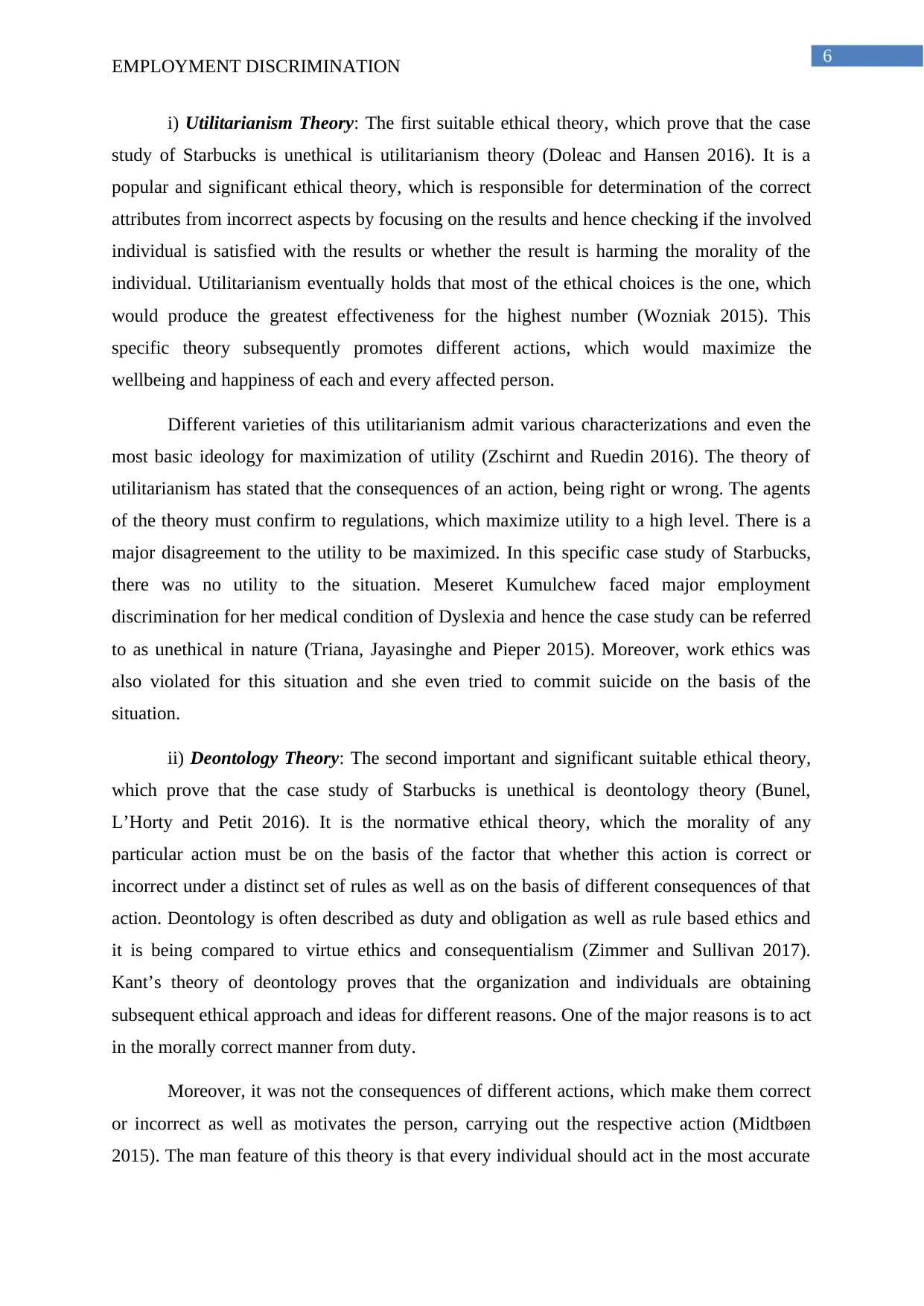
6
EMPLOYMENT DISCRIMINATION
i) Utilitarianism Theory: The first suitable ethical theory, which prove that the case
study of Starbucks is unethical is utilitarianism theory (Doleac and Hansen 2016). It is a
popular and significant ethical theory, which is responsible for determination of the correct
attributes from incorrect aspects by focusing on the results and hence checking if the involved
individual is satisfied with the results or whether the result is harming the morality of the
individual. Utilitarianism eventually holds that most of the ethical choices is the one, which
would produce the greatest effectiveness for the highest number (Wozniak 2015). This
specific theory subsequently promotes different actions, which would maximize the
wellbeing and happiness of each and every affected person.
Different varieties of this utilitarianism admit various characterizations and even the
most basic ideology for maximization of utility (Zschirnt and Ruedin 2016). The theory of
utilitarianism has stated that the consequences of an action, being right or wrong. The agents
of the theory must confirm to regulations, which maximize utility to a high level. There is a
major disagreement to the utility to be maximized. In this specific case study of Starbucks,
there was no utility to the situation. Meseret Kumulchew faced major employment
discrimination for her medical condition of Dyslexia and hence the case study can be referred
to as unethical in nature (Triana, Jayasinghe and Pieper 2015). Moreover, work ethics was
also violated for this situation and she even tried to commit suicide on the basis of the
situation.
ii) Deontology Theory: The second important and significant suitable ethical theory,
which prove that the case study of Starbucks is unethical is deontology theory (Bunel,
L’Horty and Petit 2016). It is the normative ethical theory, which the morality of any
particular action must be on the basis of the factor that whether this action is correct or
incorrect under a distinct set of rules as well as on the basis of different consequences of that
action. Deontology is often described as duty and obligation as well as rule based ethics and
it is being compared to virtue ethics and consequentialism (Zimmer and Sullivan 2017).
Kant’s theory of deontology proves that the organization and individuals are obtaining
subsequent ethical approach and ideas for different reasons. One of the major reasons is to act
in the morally correct manner from duty.
Moreover, it was not the consequences of different actions, which make them correct
or incorrect as well as motivates the person, carrying out the respective action (Midtbøen
2015). The man feature of this theory is that every individual should act in the most accurate
EMPLOYMENT DISCRIMINATION
i) Utilitarianism Theory: The first suitable ethical theory, which prove that the case
study of Starbucks is unethical is utilitarianism theory (Doleac and Hansen 2016). It is a
popular and significant ethical theory, which is responsible for determination of the correct
attributes from incorrect aspects by focusing on the results and hence checking if the involved
individual is satisfied with the results or whether the result is harming the morality of the
individual. Utilitarianism eventually holds that most of the ethical choices is the one, which
would produce the greatest effectiveness for the highest number (Wozniak 2015). This
specific theory subsequently promotes different actions, which would maximize the
wellbeing and happiness of each and every affected person.
Different varieties of this utilitarianism admit various characterizations and even the
most basic ideology for maximization of utility (Zschirnt and Ruedin 2016). The theory of
utilitarianism has stated that the consequences of an action, being right or wrong. The agents
of the theory must confirm to regulations, which maximize utility to a high level. There is a
major disagreement to the utility to be maximized. In this specific case study of Starbucks,
there was no utility to the situation. Meseret Kumulchew faced major employment
discrimination for her medical condition of Dyslexia and hence the case study can be referred
to as unethical in nature (Triana, Jayasinghe and Pieper 2015). Moreover, work ethics was
also violated for this situation and she even tried to commit suicide on the basis of the
situation.
ii) Deontology Theory: The second important and significant suitable ethical theory,
which prove that the case study of Starbucks is unethical is deontology theory (Bunel,
L’Horty and Petit 2016). It is the normative ethical theory, which the morality of any
particular action must be on the basis of the factor that whether this action is correct or
incorrect under a distinct set of rules as well as on the basis of different consequences of that
action. Deontology is often described as duty and obligation as well as rule based ethics and
it is being compared to virtue ethics and consequentialism (Zimmer and Sullivan 2017).
Kant’s theory of deontology proves that the organization and individuals are obtaining
subsequent ethical approach and ideas for different reasons. One of the major reasons is to act
in the morally correct manner from duty.
Moreover, it was not the consequences of different actions, which make them correct
or incorrect as well as motivates the person, carrying out the respective action (Midtbøen
2015). The man feature of this theory is that every individual should act in the most accurate
Paraphrase This Document
Need a fresh take? Get an instant paraphrase of this document with our AI Paraphraser
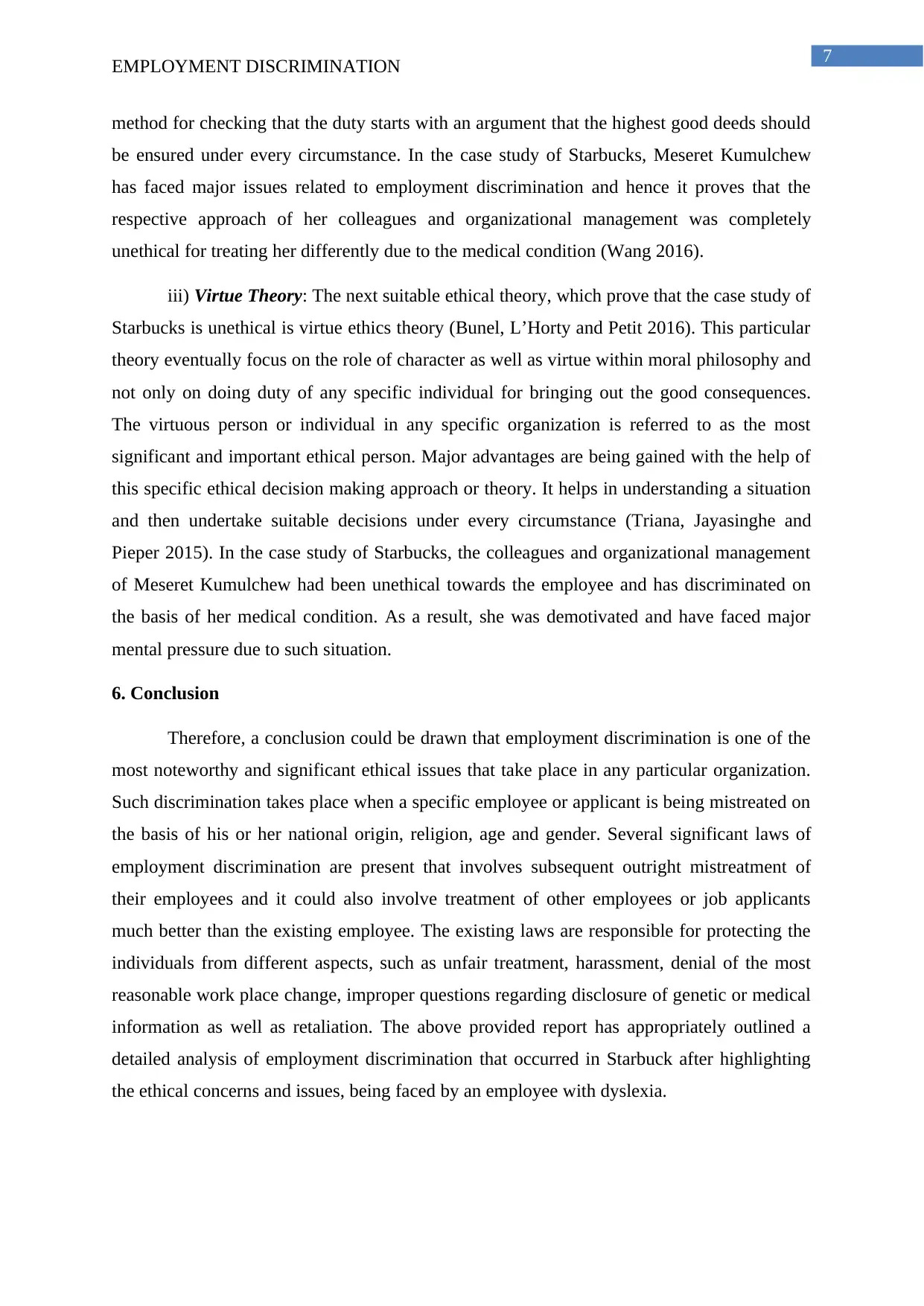
7
EMPLOYMENT DISCRIMINATION
method for checking that the duty starts with an argument that the highest good deeds should
be ensured under every circumstance. In the case study of Starbucks, Meseret Kumulchew
has faced major issues related to employment discrimination and hence it proves that the
respective approach of her colleagues and organizational management was completely
unethical for treating her differently due to the medical condition (Wang 2016).
iii) Virtue Theory: The next suitable ethical theory, which prove that the case study of
Starbucks is unethical is virtue ethics theory (Bunel, L’Horty and Petit 2016). This particular
theory eventually focus on the role of character as well as virtue within moral philosophy and
not only on doing duty of any specific individual for bringing out the good consequences.
The virtuous person or individual in any specific organization is referred to as the most
significant and important ethical person. Major advantages are being gained with the help of
this specific ethical decision making approach or theory. It helps in understanding a situation
and then undertake suitable decisions under every circumstance (Triana, Jayasinghe and
Pieper 2015). In the case study of Starbucks, the colleagues and organizational management
of Meseret Kumulchew had been unethical towards the employee and has discriminated on
the basis of her medical condition. As a result, she was demotivated and have faced major
mental pressure due to such situation.
6. Conclusion
Therefore, a conclusion could be drawn that employment discrimination is one of the
most noteworthy and significant ethical issues that take place in any particular organization.
Such discrimination takes place when a specific employee or applicant is being mistreated on
the basis of his or her national origin, religion, age and gender. Several significant laws of
employment discrimination are present that involves subsequent outright mistreatment of
their employees and it could also involve treatment of other employees or job applicants
much better than the existing employee. The existing laws are responsible for protecting the
individuals from different aspects, such as unfair treatment, harassment, denial of the most
reasonable work place change, improper questions regarding disclosure of genetic or medical
information as well as retaliation. The above provided report has appropriately outlined a
detailed analysis of employment discrimination that occurred in Starbuck after highlighting
the ethical concerns and issues, being faced by an employee with dyslexia.
EMPLOYMENT DISCRIMINATION
method for checking that the duty starts with an argument that the highest good deeds should
be ensured under every circumstance. In the case study of Starbucks, Meseret Kumulchew
has faced major issues related to employment discrimination and hence it proves that the
respective approach of her colleagues and organizational management was completely
unethical for treating her differently due to the medical condition (Wang 2016).
iii) Virtue Theory: The next suitable ethical theory, which prove that the case study of
Starbucks is unethical is virtue ethics theory (Bunel, L’Horty and Petit 2016). This particular
theory eventually focus on the role of character as well as virtue within moral philosophy and
not only on doing duty of any specific individual for bringing out the good consequences.
The virtuous person or individual in any specific organization is referred to as the most
significant and important ethical person. Major advantages are being gained with the help of
this specific ethical decision making approach or theory. It helps in understanding a situation
and then undertake suitable decisions under every circumstance (Triana, Jayasinghe and
Pieper 2015). In the case study of Starbucks, the colleagues and organizational management
of Meseret Kumulchew had been unethical towards the employee and has discriminated on
the basis of her medical condition. As a result, she was demotivated and have faced major
mental pressure due to such situation.
6. Conclusion
Therefore, a conclusion could be drawn that employment discrimination is one of the
most noteworthy and significant ethical issues that take place in any particular organization.
Such discrimination takes place when a specific employee or applicant is being mistreated on
the basis of his or her national origin, religion, age and gender. Several significant laws of
employment discrimination are present that involves subsequent outright mistreatment of
their employees and it could also involve treatment of other employees or job applicants
much better than the existing employee. The existing laws are responsible for protecting the
individuals from different aspects, such as unfair treatment, harassment, denial of the most
reasonable work place change, improper questions regarding disclosure of genetic or medical
information as well as retaliation. The above provided report has appropriately outlined a
detailed analysis of employment discrimination that occurred in Starbuck after highlighting
the ethical concerns and issues, being faced by an employee with dyslexia.
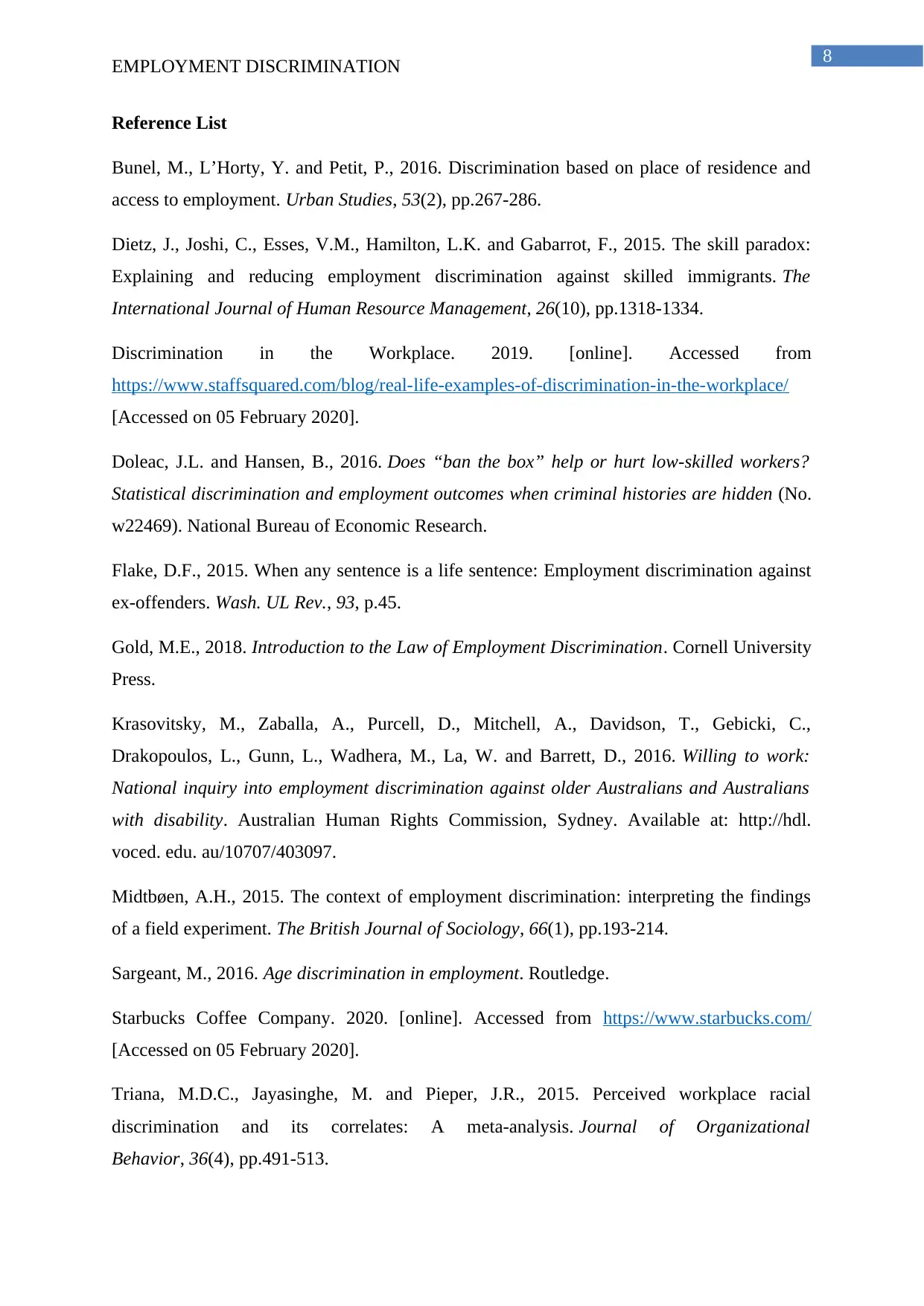
8
EMPLOYMENT DISCRIMINATION
Reference List
Bunel, M., L’Horty, Y. and Petit, P., 2016. Discrimination based on place of residence and
access to employment. Urban Studies, 53(2), pp.267-286.
Dietz, J., Joshi, C., Esses, V.M., Hamilton, L.K. and Gabarrot, F., 2015. The skill paradox:
Explaining and reducing employment discrimination against skilled immigrants. The
International Journal of Human Resource Management, 26(10), pp.1318-1334.
Discrimination in the Workplace. 2019. [online]. Accessed from
https://www.staffsquared.com/blog/real-life-examples-of-discrimination-in-the-workplace/
[Accessed on 05 February 2020].
Doleac, J.L. and Hansen, B., 2016. Does “ban the box” help or hurt low-skilled workers?
Statistical discrimination and employment outcomes when criminal histories are hidden (No.
w22469). National Bureau of Economic Research.
Flake, D.F., 2015. When any sentence is a life sentence: Employment discrimination against
ex-offenders. Wash. UL Rev., 93, p.45.
Gold, M.E., 2018. Introduction to the Law of Employment Discrimination. Cornell University
Press.
Krasovitsky, M., Zaballa, A., Purcell, D., Mitchell, A., Davidson, T., Gebicki, C.,
Drakopoulos, L., Gunn, L., Wadhera, M., La, W. and Barrett, D., 2016. Willing to work:
National inquiry into employment discrimination against older Australians and Australians
with disability. Australian Human Rights Commission, Sydney. Available at: http://hdl.
voced. edu. au/10707/403097.
Midtbøen, A.H., 2015. The context of employment discrimination: interpreting the findings
of a field experiment. The British Journal of Sociology, 66(1), pp.193-214.
Sargeant, M., 2016. Age discrimination in employment. Routledge.
Starbucks Coffee Company. 2020. [online]. Accessed from https://www.starbucks.com/
[Accessed on 05 February 2020].
Triana, M.D.C., Jayasinghe, M. and Pieper, J.R., 2015. Perceived workplace racial
discrimination and its correlates: A meta‐analysis. Journal of Organizational
Behavior, 36(4), pp.491-513.
EMPLOYMENT DISCRIMINATION
Reference List
Bunel, M., L’Horty, Y. and Petit, P., 2016. Discrimination based on place of residence and
access to employment. Urban Studies, 53(2), pp.267-286.
Dietz, J., Joshi, C., Esses, V.M., Hamilton, L.K. and Gabarrot, F., 2015. The skill paradox:
Explaining and reducing employment discrimination against skilled immigrants. The
International Journal of Human Resource Management, 26(10), pp.1318-1334.
Discrimination in the Workplace. 2019. [online]. Accessed from
https://www.staffsquared.com/blog/real-life-examples-of-discrimination-in-the-workplace/
[Accessed on 05 February 2020].
Doleac, J.L. and Hansen, B., 2016. Does “ban the box” help or hurt low-skilled workers?
Statistical discrimination and employment outcomes when criminal histories are hidden (No.
w22469). National Bureau of Economic Research.
Flake, D.F., 2015. When any sentence is a life sentence: Employment discrimination against
ex-offenders. Wash. UL Rev., 93, p.45.
Gold, M.E., 2018. Introduction to the Law of Employment Discrimination. Cornell University
Press.
Krasovitsky, M., Zaballa, A., Purcell, D., Mitchell, A., Davidson, T., Gebicki, C.,
Drakopoulos, L., Gunn, L., Wadhera, M., La, W. and Barrett, D., 2016. Willing to work:
National inquiry into employment discrimination against older Australians and Australians
with disability. Australian Human Rights Commission, Sydney. Available at: http://hdl.
voced. edu. au/10707/403097.
Midtbøen, A.H., 2015. The context of employment discrimination: interpreting the findings
of a field experiment. The British Journal of Sociology, 66(1), pp.193-214.
Sargeant, M., 2016. Age discrimination in employment. Routledge.
Starbucks Coffee Company. 2020. [online]. Accessed from https://www.starbucks.com/
[Accessed on 05 February 2020].
Triana, M.D.C., Jayasinghe, M. and Pieper, J.R., 2015. Perceived workplace racial
discrimination and its correlates: A meta‐analysis. Journal of Organizational
Behavior, 36(4), pp.491-513.
⊘ This is a preview!⊘
Do you want full access?
Subscribe today to unlock all pages.

Trusted by 1+ million students worldwide
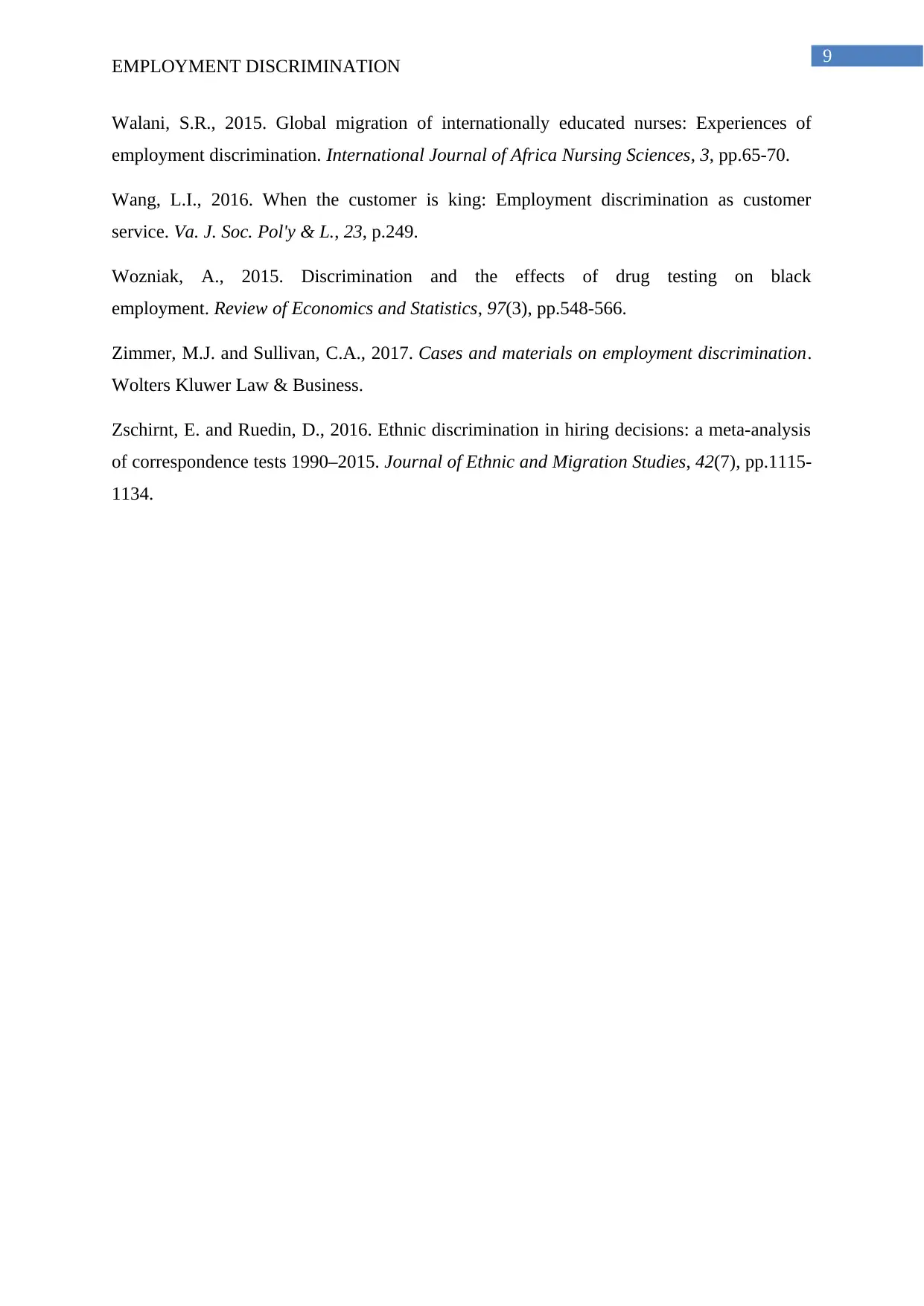
9
EMPLOYMENT DISCRIMINATION
Walani, S.R., 2015. Global migration of internationally educated nurses: Experiences of
employment discrimination. International Journal of Africa Nursing Sciences, 3, pp.65-70.
Wang, L.I., 2016. When the customer is king: Employment discrimination as customer
service. Va. J. Soc. Pol'y & L., 23, p.249.
Wozniak, A., 2015. Discrimination and the effects of drug testing on black
employment. Review of Economics and Statistics, 97(3), pp.548-566.
Zimmer, M.J. and Sullivan, C.A., 2017. Cases and materials on employment discrimination.
Wolters Kluwer Law & Business.
Zschirnt, E. and Ruedin, D., 2016. Ethnic discrimination in hiring decisions: a meta-analysis
of correspondence tests 1990–2015. Journal of Ethnic and Migration Studies, 42(7), pp.1115-
1134.
EMPLOYMENT DISCRIMINATION
Walani, S.R., 2015. Global migration of internationally educated nurses: Experiences of
employment discrimination. International Journal of Africa Nursing Sciences, 3, pp.65-70.
Wang, L.I., 2016. When the customer is king: Employment discrimination as customer
service. Va. J. Soc. Pol'y & L., 23, p.249.
Wozniak, A., 2015. Discrimination and the effects of drug testing on black
employment. Review of Economics and Statistics, 97(3), pp.548-566.
Zimmer, M.J. and Sullivan, C.A., 2017. Cases and materials on employment discrimination.
Wolters Kluwer Law & Business.
Zschirnt, E. and Ruedin, D., 2016. Ethnic discrimination in hiring decisions: a meta-analysis
of correspondence tests 1990–2015. Journal of Ethnic and Migration Studies, 42(7), pp.1115-
1134.
Paraphrase This Document
Need a fresh take? Get an instant paraphrase of this document with our AI Paraphraser
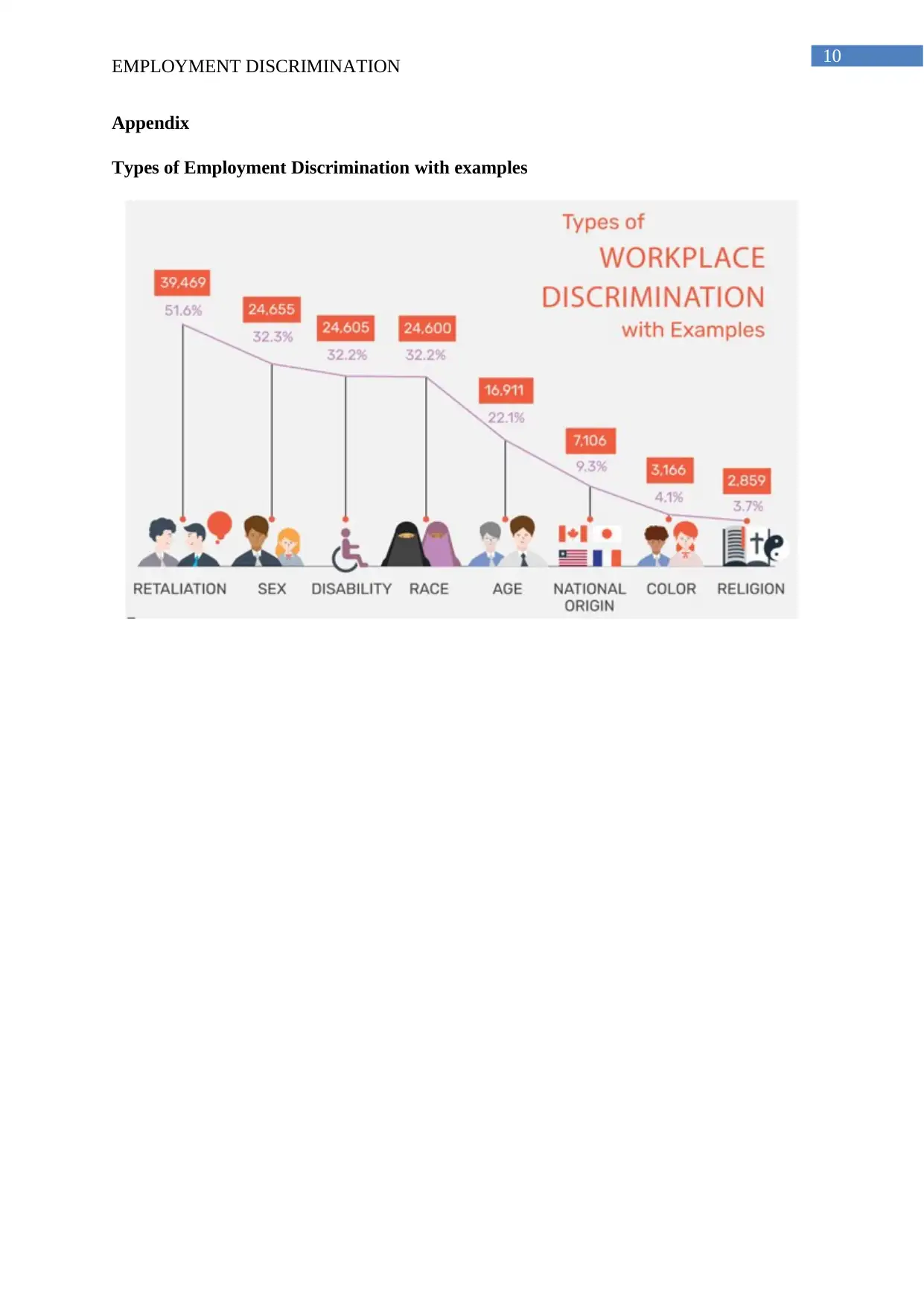
10
EMPLOYMENT DISCRIMINATION
Appendix
Types of Employment Discrimination with examples
EMPLOYMENT DISCRIMINATION
Appendix
Types of Employment Discrimination with examples
1 out of 11
Related Documents
Your All-in-One AI-Powered Toolkit for Academic Success.
+13062052269
info@desklib.com
Available 24*7 on WhatsApp / Email
![[object Object]](/_next/static/media/star-bottom.7253800d.svg)
Unlock your academic potential
Copyright © 2020–2025 A2Z Services. All Rights Reserved. Developed and managed by ZUCOL.


